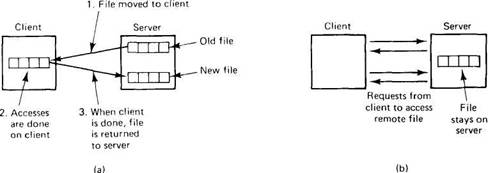Книга: Distributed operating systems
5.1.1. The File Service Interface
5.1.1. The File Service Interface
For any file service, whether for a single processor or for a distributed system, the most fundamental issue is: What is a file? In many systems, such as UNIX and MS-DOS, a file is an uninterpreted sequence of bytes. The meaning and structure of the information in the files is entirely up to the application programs; the operating system is not interested.
On mainframes, however, many types of files exist, each with different properties. A file can be structured as a sequence of records, for example, with operating system calls to read or write a particular record. The record can usually be specified by giving either its record number (i.e., position within the file) or the value of some field. In the latter case, the operating system either maintains the file as a B-tree or other suitable data structure, or uses hash tables to locate records quickly. Since most distributed systems are intended for UNIX or MS-DOS environments, most file servers support the notion of a file as a sequence of bytes rather than as a sequence of keyed records.
A files can have attributes, which are pieces of information about the file but which are not part of the file itself. Typical attributes are the owner, size, creation date, and access permissions. The file service usually provides primitives to read and write some of the attributes. For example, it may be possible to change the access permissions but not the size (other than by appending data to the file). In a few advanced systems, it may be possible to create and manipulate user-defined attributes in addition to the standard ones.
Another important aspect of the file model is whether files can be modified after they have been created. Normally, they can be, but in some distributed systems, the only file operations are CREATE and READ. Once a file has been created, it cannot be changed. Such a file is said to be immutable. Having files be immutable makes it much easier to support file caching and replication because it eliminates all the problems associated with having to update all copies of a file whenever it changes.
Protection in distributed systems uses essentially the same techniques as in single-processor systems: capabilities and access control lists. With capabilities, each user has a kind of ticket, called a capability, for each object to which it has access. The capability specifies which kinds of accesses are permitted (e.g., reading is allowed but writing is not).
All access control list schemes associate with each file a list of users who may access the file and how. The UNIX scheme, with bits for controlling reading, writing, and executing each file separately for the owner, the owner's group, and everyone else is a simplified access control list.
File services can be split into two types, depending on whether they support an upload/download model or a remote access model. In the upload/download model, shown in fig. 5-1(a), the file service provides only two major operations: read file and write file. The former operation transfers an entire file from one of the file servers to the requesting client. The latter operation transfers an entire file the other way, from client to server. Thus the conceptual model is moving whole files in either direction. The files can be stored in memory or on a local disk, as needed.

Fig. 5-1. (a) The upload/download model. (b) The remote access model.
The advantage of the upload/download model is its conceptual simplicity. Application programs fetch the files they need, then use them locally. Any modified files or newly created files are written back when the program finishes. No complicated file service interface has to be mastered to use this model. Furthermore, whole file transfer is highly efficient. However, enough storage must be available on the client to store all the files required. Furthermore, if only a fraction of a file is needed, moving the entire file is wasteful.
The other kind of file service is the remote access model, as illustrated in Fig. 5-1(b). In this model, the file service provides a large number of operations for opening and closing files, reading and writing parts of files, moving around within files (LSEEK), examining and changing file attributes, and so on. Whereas in the upload/download model, the file service merely provides physical storage and transfer, here the file system runs on the servers, not on the clients. It has the advantage of not requiring much space on the clients, as well as eliminating the need to pull in entire files when only small pieces are needed.
- 5.1.2. The Directory Server Interface
- 5.1. DISTRIBUTED FILE SYSTEM DESIGN
- The Services and Protocols Files
- 9.2.6 Other Components
- Shared Cache file
- Безопасность внешних таблиц. Параметр EXTERNAL FILE DIRECTORY
- 4.4.4 The Dispatcher
- About the author
- Chapter 7. The state machine
- Chapter 13. rc.firewall file
- Chapter 15. Graphical User Interfaces for Iptables
- Appendix E. Other resources and links




